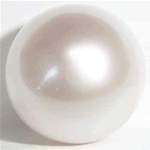
Mauktik

TRADE NAME
Pearl
ABOUT
A pearl is a hard, rounded object produced within the soft tissue (specifically the mantle) of a living shelled mollusk. Just like the shell of mollusks, a pearl is composed of calcium carbonate in minute crystalline form, which has been deposited in concentric layers. The ideal pearl is perfectly round and smooth, but many other shapes of pearls occur, see baroque pearl. Almost any shelled mollusk can, by natural processes, produce some kind of pearl when an irritating microscopic object becomes trapped within the mollusk's mantle folds, but virtually none of these pearls are considered to be gemstones.True iridescent pearls, the most desirable pearls, are produced by two groups of molluscan bivalves or clams. One family lives in the sea: the pearl oysters. The other, very different group of bivalves live in freshwater, and these are the river mussels,- Freshwater pearls form in various species of freshwater mussels, family Unionidae, which live in lakes, rivers, ponds and other bodies of fresh water. These freshwater pearl mussels occur not only in hotter climates, but also in colder more temperate areas such as Scotland, see the freshwater pearl mussel. However, most freshwater cultured pearls sold today come from China.
- Saltwater pearls grow within pearl oysters, family Pteriidae, which live in tropical oceans. Saltwater pearl oysters are usually cultivated in protected lagoons. The three main types of saltwater pearls are Akoya, South Sea and Tahitian.
SHODHAN OR AYURVEDA PURIFICATION PROCESS
NOTE
- A natural pearl is one that formed without any human intervention at all, in the wild, and these are very rare.
- A cultured pearl on the other hand, is one that has been formed on a pearl farm. The great majority of pearls on the market are cultured pearls.
SUGGESTED READING
Check wikipedia.org Entry for Mauktik.



 Your current navigation map.
Your current navigation map.